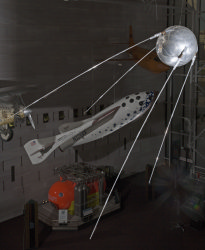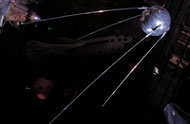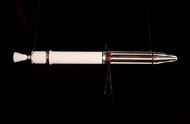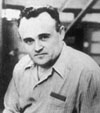
Photo by Eric Long, Smithsonian
National Air and Space Museum
|
Milestone:
First Artificial Satellite |
Date of Milestone:
October 4, 1957 |
Spacecraft:
Sputnik 1 |
Mission Operated by:
USSR |
Spacecraft Location:
Smithsonian Institution, National Air and Space Museum, Milestones of Flight Gallery
|
On October 4, 1957, the Soviet Union sent into orbit Sputnik 1, the first artificial satellite in history. Then a month later, an even larger and heavier satellite, Sputnik 2, carried the dog Laika into orbit.
Sputnik’s launch came as an unnerving surprise to the United States. The space age had dawned and America’s Cold War rival suddenly appeared technologically superior.
The first U.S. effort to launch a satellite failed when its Vanguard rocket exploded during lift-off. Finally on January 31, 1958, a Jupiter-C rocket sent Explorer 1 into orbit. The space race was underway.
Design Features (in comparison to Explorer 1):
 |
 |
Sputnik 1 |
Explorer 1 |
- More than twice the size of a basketball, Sputnik was larger and heavier than Explorer. Only the striped section of Explorer contained the payload; the rear half was a solid-fuel rocket motor.
- Sputnik’s sphere was polished to a high sheen to aid in tracking by telescope. Explorer’s light and dark stripes helped control its temperature.
- Despite Sputnik’s streamlined appearance, it tumbled while in orbit. Explorer spun about its long axis, which extended its four flexible antennas.
- Sputnik contained two radio transmitters, which sent back the “beep-beep-beep” heard round the world. Explorer contained a cosmic ray detector, radio transmitter, and temperature and micrometeoroid sensors.
People:
 Sergei P. Korolëv headed the design bureau that created the U.S.S.R.’s first intercontinental ballistic missile and Sputnik. He was adamant about making the satellite appear impressive, declaring, “This ball will be exhibited in museums!” Sergei P. Korolëv headed the design bureau that created the U.S.S.R.’s first intercontinental ballistic missile and Sputnik. He was adamant about making the satellite appear impressive, declaring, “This ball will be exhibited in museums!”
Sputnik 1
Full-size replica |
| Length: |
285 cm (112 in), antennae |
| Diameter: |
58 cm (23 in) |
| Weight: |
83.6 kg (184 lb) |
| Launch Vehicle: |
R-7 |
| Lent by the Science in Russia Exhibition of National Achievement |
More Information:
- Learn more about Explorer 1
- Learn more about the U.S.-Soviet competition in space in the Space Race exhibition (Gallery 114).
|
![]() 1947
Bell X-1 | Milestones of Flight | 1958
Explorer 1
1947
Bell X-1 | Milestones of Flight | 1958
Explorer 1 ![]()



 Sergei P. Korolëv headed the design bureau that created the U.S.S.R.’s first intercontinental ballistic missile and Sputnik. He was adamant about making the satellite appear impressive, declaring, “This ball will be exhibited in museums!”
Sergei P. Korolëv headed the design bureau that created the U.S.S.R.’s first intercontinental ballistic missile and Sputnik. He was adamant about making the satellite appear impressive, declaring, “This ball will be exhibited in museums!”